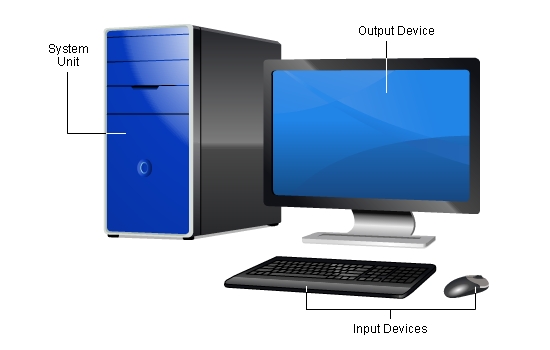
A computer is made up of many integrated circuits, wires, components, boards, slots, and chips. However, in terms of operation, a computer is made up of three fundamental elements: a system unit, output devices, and input devices.

These components work together like a team to complete tasks. The system unit acts like the center or core, processing the data and information it receives from input devices. Output devices—like printers—receive the system unit's processed information (data).
System Unit
The system unit—the core of a computer—is responsible for processing and storing data and controls all computer functions.
The system unit contains such components as the motherboard, central processing unit (CPU), random-access memory (RAM) read-only memory (ROM) chips, hard dives, CD/DVD drives, and several input/output ports. It also communicates with all of the computer's parts. In the system unit, raw data is processed into information.
The system unit works with the computer's peripheral devices. A peripheral device is equipment connected to the computer for the purpose of inputting or receiving data from the computer. There are two types of peripheral devices: output and input.
Output Device
An output device is any peripheral device that presents, displays, alters, or records output after it has left a computer's system unit. When a computer completes a computation, the resulting data is sent to an output device.
Output device data can appear in various forms such as graphics, laser light, sound, or text. Examples of output devices are monitors which display data or information onscreen, printers which create hard copy data, and speakers, which produce sound with data. Examples of output devices follow.
- Printers: Printers create images on paper, plastic, cloth, and other print media using technologies like ink transfer, heat transfer, chemical reactions, and physical force. Computer output tells printers what images, text, or designs to print.
- Monitors: A computer monitor is an output device that converts electronic signals into onscreen graphics, text, and images. Monitors are important because they give users a visual presentation of keyboard commands and mouse movements. Monitors, also called displays, are standard equipment with most computers and rely on varying types of technology. Monitors display output data and show users the end results of the processes taking place inside a computer.
Video Adapters
The video adapter is an expansion board that plugs directly into a computer's main logic board. A video adapter (video card) translates digital data from the CPU into an analog format the video display monitor can use to display images. Because the video display monitor's circuitry is analog, the video adapter's job is to act as a liaison, translating and processing digital data into analog signals that the monitor can use to display the output data.
Many motherboards have built-in video cards though they are not as powerful as standalone cards.
High-end video cards enhance rendering high resolution graphics and 3D gaming.
Other Output Devices
A number of other output devices serve many different functions. All output devices rely on the computer's output data. For example, computer speakers convert output data into sound. CD/DVD burners duplicate output data, permanently burning the data into writable discs. Digital projectors display output data as enlarged images for specialized viewing purposes.
Input Device
An input device is any peripheral appliance that generates input for the computer and allows users to enter information into the computer to be processed. Input devices allow users to provide a computer with commands, software, instructions, and information. Input devices are the pathways through which information enters a computer's system unit. Examples of input devices include: keyboard, scanner, mouse, and digitizer tablet.
- Keyboard: An input device allowing the user to type in text or enter commands into the computer. Based on the typewriter keyboard, a typical PC keyboard also contains special keys used with computer programs.
- Mouse: An input device that allows the user to point to and select items on screen. The mouse is used primarily with graphical user interface (GUI) programs to select icons and menu commands and with most drawing and paint programs.
- Trackballs: A mouse that features a rotating ball manipulated with the thumb, fingertips, or palm. A trackball's buttons are used to perform basic clicking actions such as selecting commands from a menu.
- Scanners: An input device for reading printed information, such as pictures or text, and translating scanned pictures and text into digital data the computer can understand.
- Graphic Tablet: An input device that has a touch-sensitive surface. Drawing on the tablet's surface with a special pen relays the image to the computer. The image can then be edited through a graphics application.
